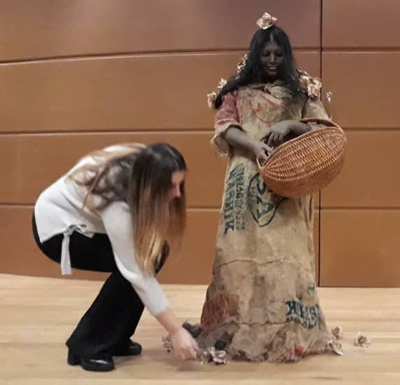Janani’s Golden Roses in Spain

Rosy reception: Janani’s performance in Oveido University
Janani Cooray ambles down Borella in a shimmering creation that stops the traffic. When she draws near, you see that she is in a Kandyan saree- yet what a parody of the saree the old matriarchs used to drape with regal grace and the trailing pethi mala and agasti mala!
Janani’s saree is a jacket and underskirt of aluminum sheet, over which is wrapped barbed wire to form the six yards with borichi sleeves, frill and palu. She can hardly walk- her steps are tortuous. That stilted gait is the icing on her performance. It amply drives home her message- how an adapted Indian garb made ‘national dress’ imprisons women. Looming behind her is a whole history of women being corseted; stifled; caged.
While Osariya, performed in 2015, was Janani’s most iconic performance art act, her very first was called Cage. It was inspired by the same theme, but with a different inflection.
The year was 2003 and Janani the artist was feeling enamoured of Lunuganga, Geoffrey Bawa’s country estate, where she was part of the Theertha Artists’ Collective’s international workshop. The Italian-tropical garden dotted with images of a tropical Pan, and the dusky Bentota lake whispered to her- and she suddenly saw that Bawa had been inspired by the ancient Sinhalese civilizations which were poised on the edge of water.
Janani gathered a few foreign friends so that each could enact a water ritual from their respective cultures. For herself, Janani chose the Sinhalese puberty rite where the girl in menarche is bathed. The bloodstained girl (Janani) after being bathed was imprisoned in a cage made of wooden poles.
She managed to bring out in a visually dark and powerfully primitive reading how women, especially after coming of age, are imprisoned.
Since that disturbing act, Janani has spread her wings to become an internationally known performance artist- with over 40 acts here and abroad.
If the phrase ‘performance art’ seems only vaguely familiar, Janani explains that it is the art of using your body as the medium to give out an (often urgent) message.
This November, Janani was part of the conference on performance art at the University of Oviedo, Spain. There, representing Asia- she did an acclaimed act called Golden Roses.
A Cinderella in a gown of gunny sacks from the Pettah (with the onion traders’ ink still etched), tousle-headed and with a cadaverously grimy face, she walked about distributing plastic roses sprayed with gold.
When she did this in Colombo earlier, the children would accept the floral offerings, and the women too with some giggling, but the men tended to act as if she was not there. “I would sometimes block their way insisting”- triggering laughter.
So, it was a surprise in Oviedo when the audience at the end clambered up to her and started decorating her with her own roses.
The symbology of Golden Roses is inspired: the roses are the dreams of the impoverished natamis of Pettah- dreams of better things. And, adroitly, she was also able to give an interpretation to the reaction of her Spanish audience. The flowers being given back to her signified “the upper classes rejecting anything that emanates from the proletarian- also negating their dreams”.
It is really this head for conjuring and executing visual metaphors that makes Janani such a powerful performance artist.
While in Spain, she was also invited to do an act at the prestigious Oscar Niemeyer International Cultural Centre, where she was covered in a tangled web of hair like a monstrous Komondor dog- entangling the audience in the matted locks- a metaphor for human relationships in which we are perpetually snarled.
The art of the body is not one that plays out in safe glades. At the Jaffna Library reopening, during the ceasefire in 2004, Janani openly criticized the LTTE and the government- for spreading falsely cheerful messages of peace. She painted a charcoal burnt papier mâché man with swatches of colour.
In India where she has performed many times, she and an Indian performer did paintings from their own blood and then fed them to a fire- over which milk was boiled. The meaning: both countries have serious bloodletting which are swept under the carpet. The milk was a sanguine symbol for a better world.
While her acts at home, especially the Osariya, became comedy fodder for social media, Janani hopes that Sri Lankans would one day soon be aesthetically cognizant enough to wake up to the dynamic art of the body- an arena where “Indians and other audiences have advanced way ahead of us”.


